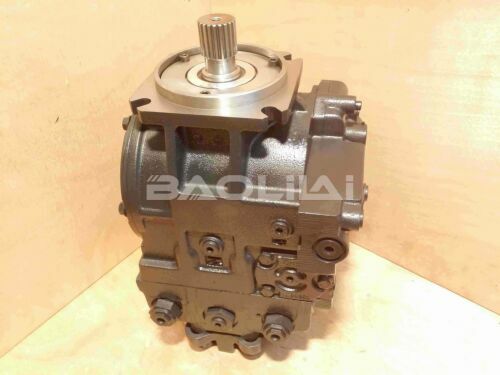Difference between plunger pump and vane pump
Both piston and vane pumps are positive displacement pumps commonly used in hydraulic systems. However, they operate using different mechanisms and have some key differences in performance and application.
Piston pumps use reciprocating motion to move fluid through the system. They consist of a cylinder block and one or more plungers that move back and forth to create suction and discharge pressure. As the plungers move back and forth, they draw fluid into the cylinder and expel it through the discharge valve. Piston pumps are capable of generating high pressure, usually with high pressure applications such as hydraulic presses, water jet cutting and high pressure cleaning systems.
Vane pumps, on the other hand, use a rotating impeller with blades that slide in and out of slots in the pump casing. The vanes form the chambers that draw fluid into the pump and expel it through the outlet. Vane pumps typically operate at lower pressures than piston pumps and are commonly used in medium pressure applications such as power steering, lubrication systems and transmissions.90-R-250-KN-5-NN-80-S-4-C8-K-05-NNN-35-35-20 90R250KN5NN80S4C8K05NNN353520
90R250-KN-5-NN-80-S-4-C8-K-05-NNN-35-35-20 90R250KN5NN80S4C8K05NNN353520
90-R-250-KN-5-NN-80-S-4-C8-J-03-NNN-26-26-24 90R250KN5NN80S4C8J03NNN262624
90R250-KN-5-NN-80-S-4-C8-J-03-NNN-26-26-24 90R250KN5NN80S4C8J03NNN262624
90-R-250-KN-5-NN-80-S-4-C8-J-02-NNN-36-36-24 90R250KN5NN80S4C8J02NNN363624
90R250-KN-5-NN-80-S-4-C8-J-02-NNN-36-36-24 90R250KN5NN80S4C8J02NNN363624
90-R-250-KN-5-NN-80-S-3-C8-K-03-NNN-26-26-24 90R250KN5NN80S3C8K03NNN262624
90R250-KN-5-NN-80-S-3-C8-K-03-NNN-26-26-24 90R250KN5NN80S3C8K03NNN262624
90-R-250-KN-5-NN-80-S-3-C8-K-03-NNN-20-20-24 90R250KN5NN80S3C8K03NNN202024
90R250-KN-5-NN-80-S-3-C8-K-03-NNN-20-20-24 90R250KN5NN80S3C8K03NNN202024
Some of the key differences between piston and vane pumps include:
Pressure Rating: Piston pumps are generally capable of producing much higher pressures than vane pumps. Piston pumps can generate pressures of up to 10,000 psi or more, while vane pumps typically operate at 2,500 psi or less.
Efficiency: Piston pumps are generally more efficient than vane pumps, especially at high pressures. This is because plunger pumps have less internal leakage and a more direct fluid flow path.
Noise level: Vane pumps are generally quieter than piston pumps because they run smoother and operate at lower pressures.
Maintenance: Piston pumps require more maintenance than vane pumps due to their more complex design and higher operating pressures. Piston pumps may also require more frequent replacement of parts such as seals, gaskets and valves.
Cost: Piston pumps are generally more expensive than vane pumps because of their more complex design and higher operating pressures. However, the higher cost may be offset by the increased efficiency and longer life of the plunger pump in high pressure applications.

Size and Weight: Piston pumps are typically larger and heavier than vane pumps due to their more complex design and higher pressure capabilities. In applications where space and weight are limited, this may be a consideration.
Control: Piston pumps allow better control of fluid flow and pressure, making them suitable for applications requiring high precision and accuracy. Vane pumps are less precise but offer simpler control options, making them suitable for applications that require less precision.
All in all, both piston and vane pumps have advantages and disadvantages, and the choice between them will depend on the specific requirements of the application. Factors to consider include pressure, efficiency, noise level, maintenance, cost, size and weight, and control options. A qualified hydraulic system designer or engineer can assist in selecting choose the most suitable pump.
90-R-250-KN-5-EG-80-T-4-C8-K-03-NNN-35-35-24 90R250KN5EG80T4C8K03NNN353524
90R250-KN-5-EG-80-T-4-C8-K-03-NNN-35-35-24 90R250KN5EG80T4C8K03NNN353524
90-R-250-KN-5-EG-80-T-3-C8-K-06-NNN-35-35-30 90R250KN5EG80T3C8K06NNN353530
90R250-KN-5-EG-80-T-3-C8-K-06-NNN-35-35-30 90R250KN5EG80T3C8K06NNN353530
90-R-250-KN-5-EG-80-T-3-C8-K-03-NNN-40-40-28 90R250KN5EG80T3C8K03NNN404028
90R250-KN-5-EG-80-T-3-C8-K-03-NNN-40-40-28 90R250KN5EG80T3C8K03NNN404028
90-R-250-KN-5-EG-80-T-3-C8-K-03-NNN-35-35-24 90R250KN5EG80T3C8K03NNN353524
90R250-KN-5-EG-80-T-3-C8-K-03-NNN-35-35-24 90R250KN5EG80T3C8K03NNN353524
90-R-250-KN-5-EG-80-S-4-C8-J-03-NNN-38-38-24 90R250KN5EG80S4C8J03NNN383824
90R250-KN-5-EG-80-S-4-C8-J-03-NNN-38-38-24 90R250KN5EG80S4C8J03NNN383824
Application: Piston pumps are commonly used in high pressure applications such as water jet cutting, pressure washing and hydraulic presses. They are also commonly used in oil and gas exploration, drilling and production. Vane pumps are commonly used in low-pressure applications such as power steering systems, hydraulic lifts, and machine tool coolant systems.
Maintenance: Piston pumps generally require more maintenance than vane pumps due to their more complex design and higher pressure capabilities. However, regular maintenance can extend the life of the pump and ensure reliable operation. Vane pumps are generally easier to maintain and repair.
Noise level: Piston pumps are generally noisier than vane pumps due to higher pressures and more complex designs. This may be a consideration in applications where noise levels need to be kept low.
Ultimately, the choice between piston and vane pumps will depend on the specific requirements of the application. Both types of pumps have their advantages and disadvantages, and a qualified hydraulic system designer or engineer can help determine which type of pump is best for a given application.
This article is published by the official website of Baolilai Hydraulics, please contact the author and indicate the source for reprinting:https://www.baolilai-pump.cn/news/335.html






